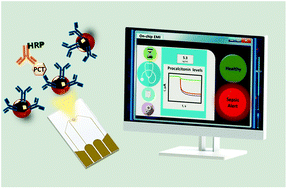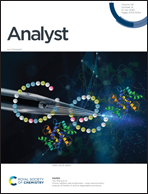An on-chip microfluidic-based electrochemical magneto-immunoassay for the determination of procalcitonin in plasma obtained from sepsis diagnosed preterm neonates
Abstract
A novel on-chip electrochemical magneto-immunoassay for the determination of procalcitonin (PCT) has been proposed. The strategy involved the on-line performing of the biorecognition event and detection on the thin-film microfluidic gold electrode chamber operating at E = −0.20 V (vs. Au). The complete assay was performed in less than 15 minutes using only 25 μL of the sample, covering the entire range of clinically relevant PCT concentrations in sepsis diagnosis with a limit of detection and quantification of 0.02 ng mL−1 and 0.05 ng mL−1, respectively (the sepsis diagnosis threshold: 0.5 ng mL−1). The on-chip electrochemical magneto-immunoassay provided excellent results in the analysis of very unique samples obtained from preterm neonates admitted with suspected sepsis, in which the sample volume is hardly available. These characteristics fulfill the POCT requirements for PCT determination in the whole clinically relevant concentration range. Because of the high clinical relevance and the important role of PCT in sepsis, this approach opens new perspectives for sepsis diagnosis and therapy guidance using low volume samples.



 Please wait while we load your content...
Please wait while we load your content...